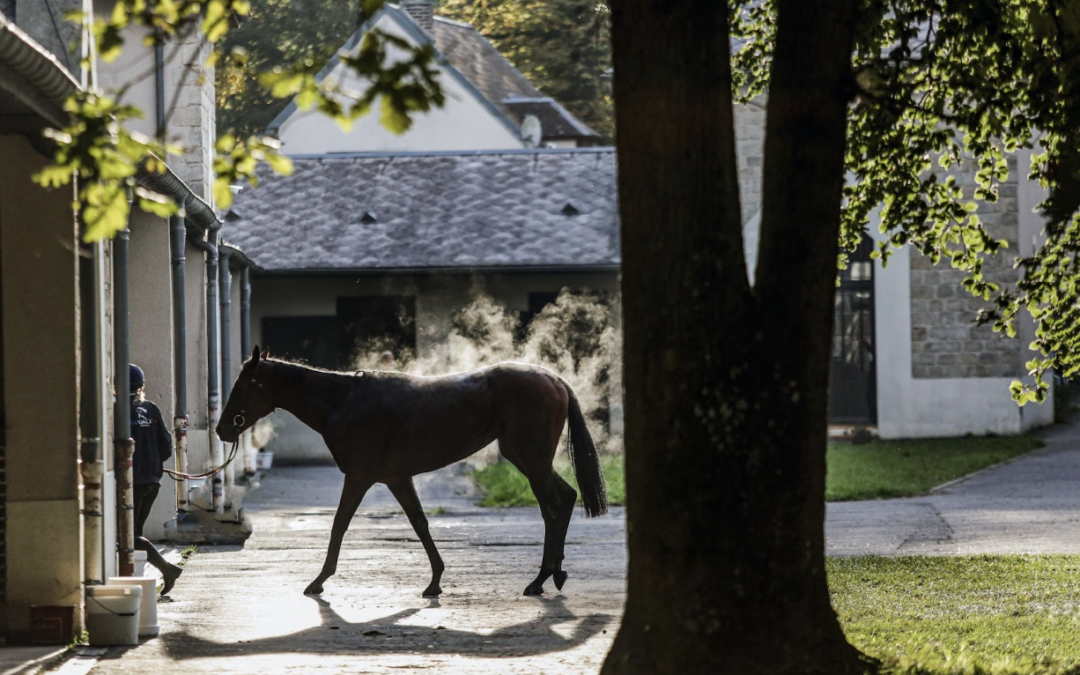Overtraining is characterized by an imbalance between training activity and recovery periods, resulting in chronic fatigue and impaired performance, often associated with physiological and psychological changes. Overtraining results from a combination of physical and psychological stress. Sources of physical stress include training, environmental factors, and nutrition. Overtraining can result in underperformance and loss of results. Daily monitoring can help prevent this and detect weak signals to avoid accidents.
What‘s the link between over-training and underperformance? What are the causes of underperformance caused by overtraining? What are the symptoms associated with underperformance? What impact do these symptoms have on the horse, and what preventive measures can be taken?
If you’re interested in investigating underperformance in racehorses, we recommend you read this article.
The link between overtraining and underperformance
Overtraining occurs when the recovery period is prolonged and fatigue persists for several weeks. This condition is manifested by a reduction in performance and associated symptoms, including somatic, psychosomatic, endocrine, and immunological aspects. According to (P.Pilardeau (1976)) Overtraining, whether physical or psychological, is directly related to the hypothalamus. Clinical manifestations such as sleep disturbances, appetite disturbances, stress, muscle wasting, energy depletion, and tachycardia have their origins in dysfunctions of the hypothalamus and the resulting hormonal messages.
Research carried out in 1999 by Tyler et al. on 13 American trotters revealed that overtraining mainly manifests itself as a reduction in the length of time the horse can maintain his effort.
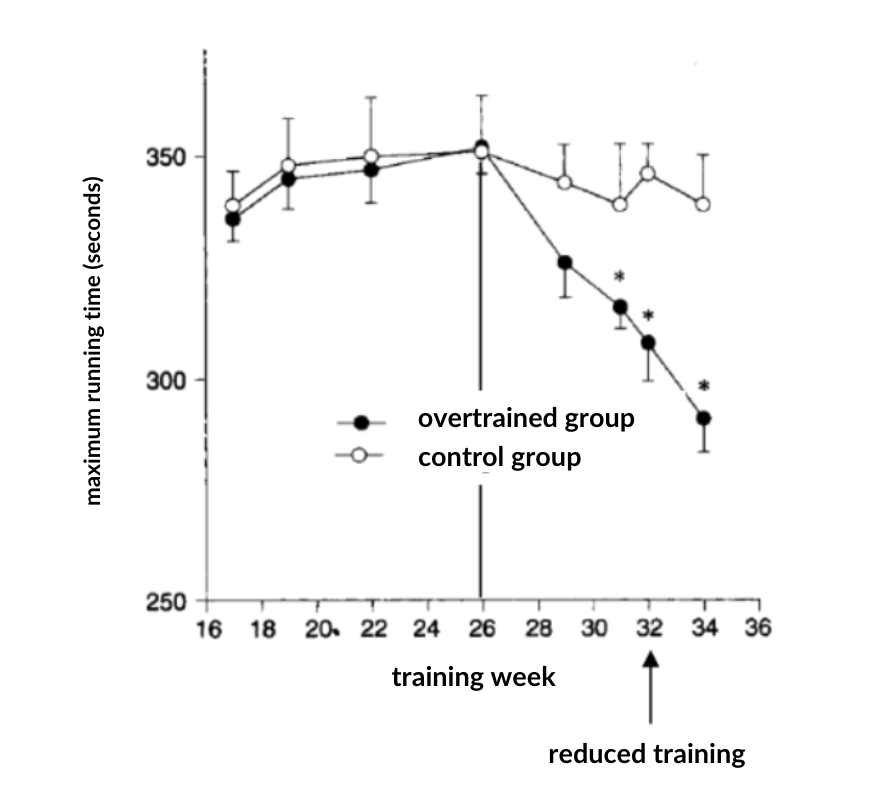
Overtraining develops progressively, as shown in this study, where a reduction in the amount of time the horse can sustain his effort is observed from week 26 onwards. Even with a reduction in training intensity and frequency from the thirty-second week onwards, performance continues to deteriorate, leading to overtraining-induced underperformance of the horse.
Overtraining leads to underperformance, a logical consequence of fatigue, over-exertion, and poor recovery. In these syndromes of underperformance and overtraining, notable similarities between man and horse are regularly highlighted by certain studies, correlating manifestations of counter-performance with overtraining in both cases.
The causes of underperformance caused by overtraining
The causes of overtraining fall into 2 categories:
– Mechanical overtraining: musculoskeletal tissues cannot cope with the increased demands of training.
– Metabolic overtraining: an imbalance between training and rest can lead to dysfunction of central systems, with possible changes in behavior.
Various factors contribute to overtraining, with the accumulation of stress (resulting in increased cortisol) during training, being one of the main causes. Excessive stress during training can have a lasting impact on a horse’s performance. According to (S.Le Gal (2012)), training stress must be carefully dosed to stimulate adaptation. If it is too severe, it can lead to “maladaptation” and a decline in performance over time.
The origin of overtraining can vary depending on the exercise, with various potential sources such as stress or pain.
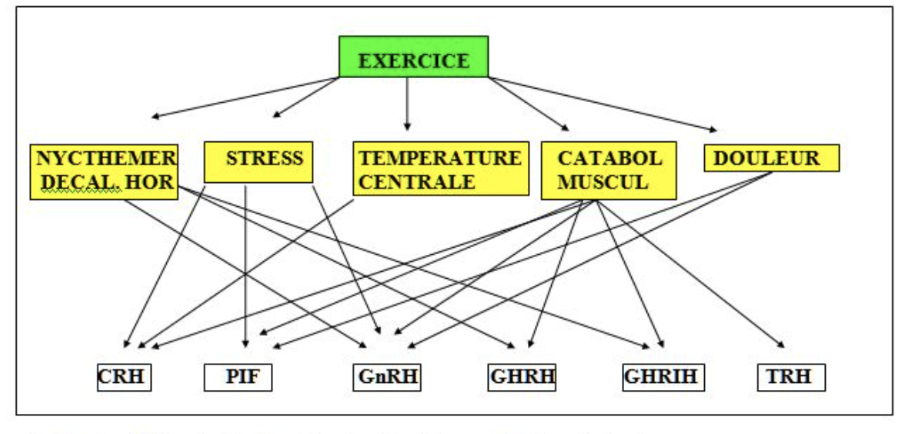
Médecine évolution phylosophie – Origin of overtraining
Different parameters can be introduced into the veterinarian’s research area in the underperformance analysis:
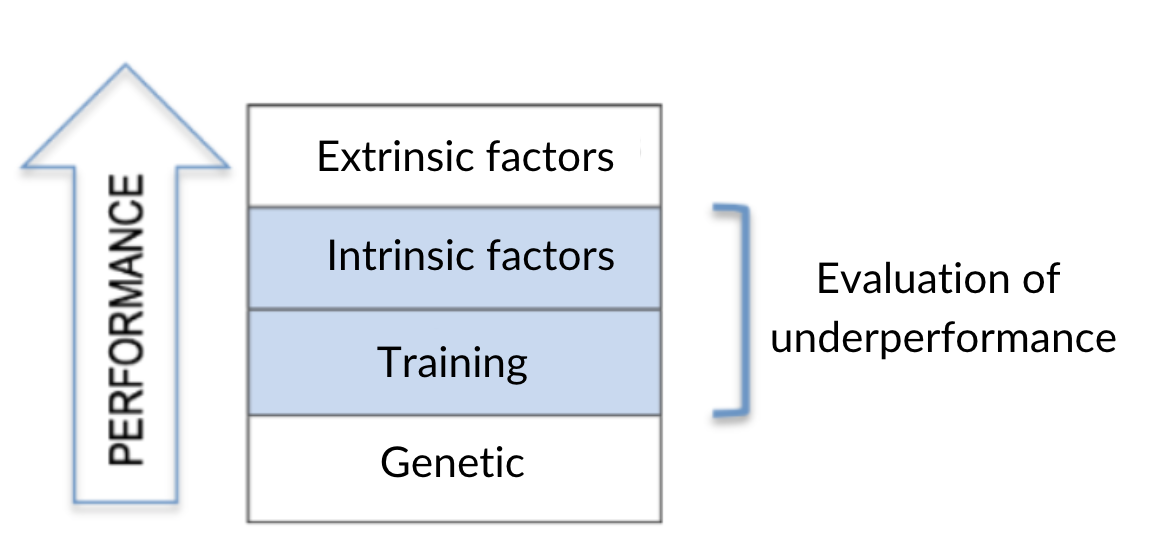
“Medical and sports monitoring of the show jumping horse: managing the sporting career” Arnaud LEHN
Concerning intrinsic factors, studies on racehorses (Couëtil & Denicola 1999, Van Erck et al. 2006) examining bronchoalveolar lavage samples concluded that subclinical pathologies affecting the deep respiratory tract have a significant incidence.
Statistics from the Centre de Médecine Sportive de Liège on 345 horses referred for underperformance show that 86% were due to respiratory pathologies, with 32% involving the upper respiratory tract and 54% the deep respiratory tract.
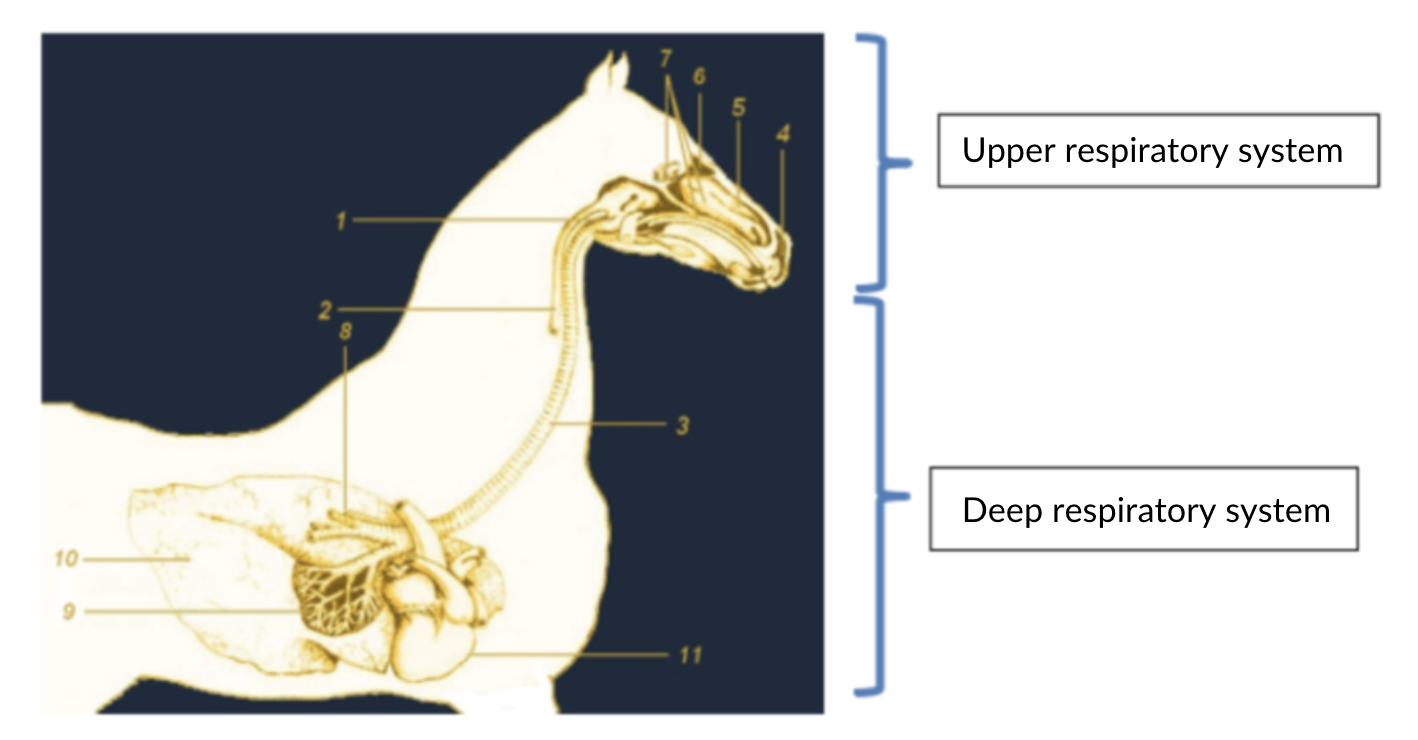
https://www.lacompagniedesanimaux.com/conseil-veterinaire/tout-savoir-sur-la-toux-du-cheval.html
The respiratory system is not the only cause of underperformance in horses: studies by (Morris & Seeherman 1991 and Martin et al. 2000) have determined that the primary cause of underperformance and exercise intolerance is musculoskeletal pathology. A reproducible and attentive work program, incorporating varied stress levels while ensuring adequate activity to promote optimal cardiovascular development, will achieve the best results while reducing the risk of gastric ulcers and musculoskeletal pain.
Locomotor pathologies should also be mentioned as a cause of underperformance, as limping is the leading cause of underperformance in sport horses (Bathe 2008). Limping can be the result of over-training.
Regarding extrasics factors are concerned, we can, of course, mention the causes of underperformance which are due to the environment, diet, work program, and training. This includes overtraining. Some pathologies are linked to the horse‘s lifestyle and can be directly modified by humans.
Associated symptoms:
Overtraining initially manifests as a drop in performance, even when the training level is maintained. Furthermore, a rest period of 11 days to 3 weeks does not lead to an improvement in performance, thus distinguishing overtraining from temporary maladaptation.
One of the earliest indicators is weight loss, according to the study by (Tyler et al. presented above), as this occurred 3 weeks before the drop in performance. Behavioural changes are also good indicators of overtraining, with irritability and reluctance to work, but the signs of disturbance can be many and varied: biting harnesses, head-butting, and disobedience…
This can result in a reduction in the horse‘s performance level, assuming that the previous level was acceptable at this stage of training. Secondly, there may be effort intolerance, characterised by a significant drop in the usual level of performance and an inability to train at a similar intensity as previously used. Finally, the inability to compete at the expected level can have various reasons, including a horse that has not yet confirmed his abilities, and whose potential has been overestimated, expectations based on physical or genetic criteria, or an insufficient level of training.
The impact of these syndromes on the horse and preventive measures to adopt
Important indicators for preventing overtraining include monitoring the frequency, intensity, and duration of exercise, along with considering the recovery period. Time spent in the paddock and international travel can also contribute to overtraining in sport horses.
The significance of recovery time is paramount in horse training. Implementing good practices, both active and passive, is crucial to avoiding overtraining and preventing an excessive reaction of the horse’s body to fatigue and muscle damage.
In sport horses, the locomotor system is the main focus of monitoring. The cardiac, respiratory, and digestive systems are also the subject of a veterinary consultation every time, but particular attention is paid to the orthopedic examination in the event of a drop in performance.
Over the years, technology has developed into a major asset in veterinary care. The veterinarian‘s expert eye, combined with numerical or pictorial data, allows for an efficient and comprehensive examination. For horses with regular physical activity and recurrent training, veterinary monitoring should be carried out at least once a week.
Similar to detecting a limping injury, early detection is key to maintaining the horse’s optimal working conditions and limiting or preventing the appearance of after-effects.
To prevent underperformance in horses, a prevention system must be established upstream. The horse‘s use of his body during training is much more intense than in a traditional locomotor examination surpassing the stresses of conventional functional tests. This intensity allows an experienced practitioner to detect anomalies in the sporting gesture or other locomotor defects, often responsible for underperformance. Introducing monitoring is interesting, enabling the analysis of the horse’s performance during work and intense physical exercise. Our Equisym solution is a tool adapted to veterinary problems of this type, designed to assist veterinarians daily in the diagnosis of locomotor asymmetries.
Equisym facilitated the objective quantification of locomotion with a global perspective (complex and multiple limping, visualisation of kinematic data synchronised with video), as part of preventive and follow-up work. Equisym enables analysis of locomotion in all three gaits, to study the horse‘s movement as a whole.
In the example below, we observe a deterioration in locomotion over time. Each curve corresponds to a locomotor examination conducted one month apart, illustrating the elevation of the withers at the base of each diagonal trotting step.
The respiratory system is not the only cause of underperformance in horses: studies by (Morris & Seeherman 1991 and Martin et al. 2000) have determined that the primary cause of underperformance and exercise intolerance is musculoskeletal pathology. A reproducible and attentive work program, incorporating varied stress levels while ensuring adequate activity to promote optimal cardiovascular development, will achieve the best results while reducing the risk of gastric ulcers and musculoskeletal pain.
Locomotor pathologies should also be mentioned as a cause of underperformance, as limping is the leading cause of underperformance in sport horses (Bathe 2008). Limping can be the result of over-training.
Regarding extrasics factors are concerned, we can, of course, mention the causes of underperformance which are due to the environment, diet, work program, and training. This includes overtraining. Some pathologies are linked to the horse‘s lifestyle and can be directly modified by humans.
Associated symptoms:
Overtraining initially manifests as a drop in performance, even when the training level is maintained. Furthermore, a rest period of 11 days to 3 weeks does not lead to an improvement in performance, thus distinguishing overtraining from temporary maladaptation.
One of the earliest indicators is weight loss, according to the study by (Tyler et al. presented above), as this occurred 3 weeks before the drop in performance. Behavioural changes are also good indicators of overtraining, with irritability and reluctance to work, but the signs of disturbance can be many and varied: biting harnesses, head-butting, and disobedience…
This can result in a reduction in the horse‘s performance level, assuming that the previous level was acceptable at this stage of training. Secondly, there may be effort intolerance, characterised by a significant drop in the usual level of performance and an inability to train at a similar intensity as previously used. Finally, the inability to compete at the expected level can have various reasons, including a horse that has not yet confirmed his abilities, and whose potential has been overestimated, expectations based on physical or genetic criteria, or an insufficient level of training.
The impact of these syndromes on the horse and preventive measures to adopt
Important indicators for preventing overtraining include monitoring the frequency, intensity, and duration of exercise, along with considering the recovery period. Time spent in the paddock and international travel can also contribute to overtraining in sport horses.
The significance of recovery time is paramount in horse training. Implementing good practices, both active and passive, is crucial to avoiding overtraining and preventing an excessive reaction of the horse’s body to fatigue and muscle damage.
In sport horses, the locomotor system is the main focus of monitoring. The cardiac, respiratory, and digestive systems are also the subject of a veterinary consultation every time, but particular attention is paid to the orthopedic examination in the event of a drop in performance.
Over the years, technology has developed into a major asset in veterinary care. The veterinarian‘s expert eye, combined with numerical or pictorial data, allows for an efficient and comprehensive examination. For horses with regular physical activity and recurrent training, veterinary monitoring should be carried out at least once a week.
Similar to detecting a limping injury, early detection is key to maintaining the horse’s optimal working conditions and limiting or preventing the appearance of after-effects.
To prevent underperformance in horses, a prevention system must be established upstream. The horse‘s use of his body during training is much more intense than in a traditional locomotor examination surpassing the stresses of conventional functional tests. This intensity allows an experienced practitioner to detect anomalies in the sporting gesture or other locomotor defects, often responsible for underperformance. Introducing monitoring is interesting, enabling the analysis of the horse’s performance during work and intense physical exercise. Our Equisym solution is a tool adapted to veterinary problems of this type, designed to assist veterinarians daily in the diagnosis of locomotor asymmetries.
Equisym facilitated the objective quantification of locomotion with a global perspective (complex and multiple limping, visualisation of kinematic data synchronised with video), as part of preventive and follow-up work. Equisym enables analysis of locomotion in all three gaits, to study the horse‘s movement as a whole.
In the example below, we observe a deterioration in locomotion over time. Each curve corresponds to a locomotor examination conducted one month apart, illustrating the elevation of the withers at the base of each diagonal trotting step.
The respiratory system is not the only cause of underperformance in horses: studies by (Morris & Seeherman 1991 and Martin et al. 2000) have determined that the primary cause of underperformance and exercise intolerance is musculoskeletal pathology. A reproducible and attentive work program, incorporating varied stress levels while ensuring adequate activity to promote optimal cardiovascular development, will achieve the best results while reducing the risk of gastric ulcers and musculoskeletal pain.
Locomotor pathologies should also be mentioned as a cause of underperformance, as limping is the leading cause of underperformance in sport horses (Bathe 2008). Limping can be the result of over-training.
Regarding extrasics factors are concerned, we can, of course, mention the causes of underperformance which are due to the environment, diet, work program, and training. This includes overtraining. Some pathologies are linked to the horse‘s lifestyle and can be directly modified by humans.
Associated symptoms:
Overtraining initially manifests as a drop in performance, even when the training level is maintained. Furthermore, a rest period of 11 days to 3 weeks does not lead to an improvement in performance, thus distinguishing overtraining from temporary maladaptation.
One of the earliest indicators is weight loss, according to the study by (Tyler et al. presented above), as this occurred 3 weeks before the drop in performance. Behavioural changes are also good indicators of overtraining, with irritability and reluctance to work, but the signs of disturbance can be many and varied: biting harnesses, head-butting, and disobedience…
This can result in a reduction in the horse‘s performance level, assuming that the previous level was acceptable at this stage of training. Secondly, there may be effort intolerance, characterised by a significant drop in the usual level of performance and an inability to train at a similar intensity as previously used. Finally, the inability to compete at the expected level can have various reasons, including a horse that has not yet confirmed his abilities, and whose potential has been overestimated, expectations based on physical or genetic criteria, or an insufficient level of training.
The impact of these syndromes on the horse and preventive measures to adopt
Important indicators for preventing overtraining include monitoring the frequency, intensity, and duration of exercise, along with considering the recovery period. Time spent in the paddock and international travel can also contribute to overtraining in sport horses.
The significance of recovery time is paramount in horse training. Implementing good practices, both active and passive, is crucial to avoiding overtraining and preventing an excessive reaction of the horse’s body to fatigue and muscle damage.
In sport horses, the locomotor system is the main focus of monitoring. The cardiac, respiratory, and digestive systems are also the subject of a veterinary consultation every time, but particular attention is paid to the orthopedic examination in the event of a drop in performance.
Over the years, technology has developed into a major asset in veterinary care. The veterinarian‘s expert eye, combined with numerical or pictorial data, allows for an efficient and comprehensive examination. For horses with regular physical activity and recurrent training, veterinary monitoring should be carried out at least once a week.
Similar to detecting a limping injury, early detection is key to maintaining the horse’s optimal working conditions and limiting or preventing the appearance of after-effects.
To prevent underperformance in horses, a prevention system must be established upstream. The horse‘s use of his body during training is much more intense than in a traditional locomotor examination surpassing the stresses of conventional functional tests. This intensity allows an experienced practitioner to detect anomalies in the sporting gesture or other locomotor defects, often responsible for underperformance. Introducing monitoring is interesting, enabling the analysis of the horse’s performance during work and intense physical exercise. Our Equisym solution is a tool adapted to veterinary problems of this type, designed to assist veterinarians daily in the diagnosis of locomotor asymmetries.
Equisym facilitated the objective quantification of locomotion with a global perspective (complex and multiple limping, visualisation of kinematic data synchronised with video), as part of preventive and follow-up work. Equisym enables analysis of locomotion in all three gaits, to study the horse‘s movement as a whole.
In the example below, we observe a deterioration in locomotion over time. Each curve corresponds to a locomotor examination conducted one month apart, illustrating the elevation of the withers at the base of each diagonal trotting step.
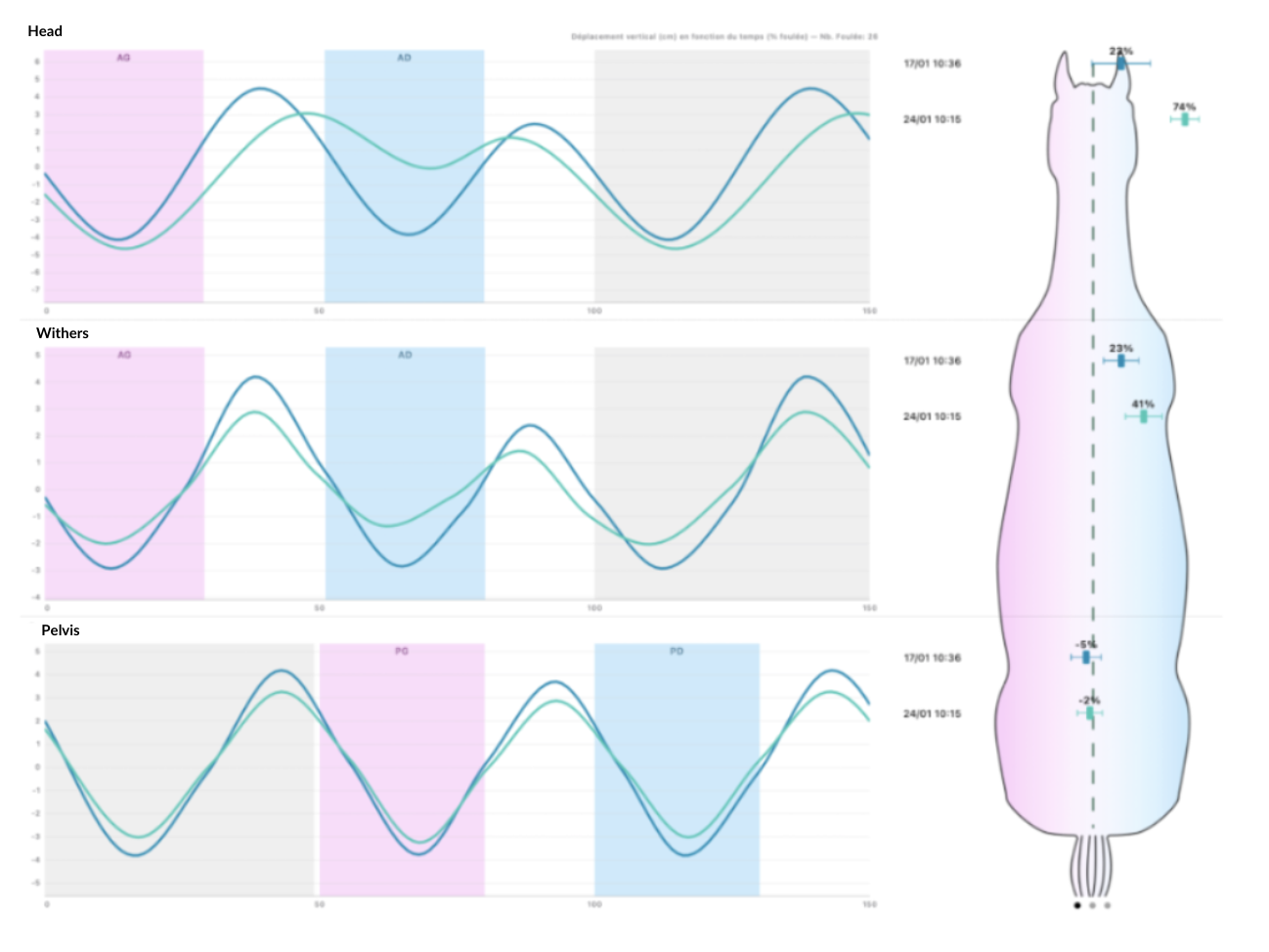
Data from the Equisym platform.
Another monitoring tool available to quantify and detect overtraining and underperformance is Equimetre.
Equimetre quantifies the horse‘s heart rate, which can be observed before, during, and after training to follow the curves and visualise whether the horse‘s recovery is optimal or needs to be worked on. It‘s a good indicator of the horse‘s health, supporting the vet‘s eye and enabling daily, preventive monitoring. A tool dedicated to equine health management, it aids diagnosis, pathology detection, prevention, and follow-up. With a complete ECG, it‘s a real asset for the veterinarian.
In the example below, poor recovery is a warning signal for the veterinarian, who can call on an ECG analysis for diagnosis.
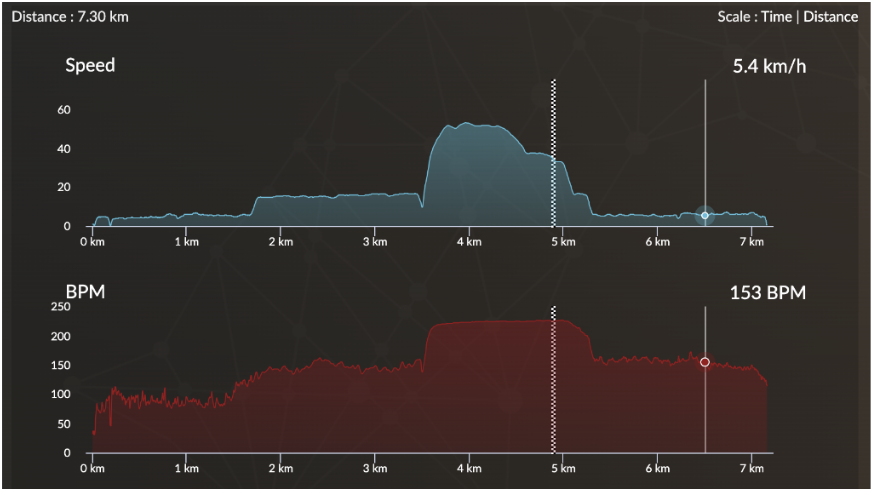
Data from the Equimetre platform.
Last but not least, standardised test of effort enables you to apply an intensity of effort that demands the body, while keeping it below competition level. A standardised test of effort is, therefore, a perfectly comparable exercise for monitoring the relevant indicators to detect dips in fitness before the onset of overtraining syndromes.
Conclusion
Overtraining is one of the main causes of underperformance in athletic horses, with various repercussions at both technical and economic levels. It results from an imbalance between the stress generated by training loads, and the horse’s capacity to adapt and recover.
Technology and the rigorous monitoring of cardiac, locomotor and respiratory parameters present interesting opportunities for preventing counter-performance in the horse athlete.
SOURCES :
- EQUINE VETERINARY JOURNAL Equine vet. J. (2008) Unexplained underperformance syndrome in sport horses: Classification, potential causes and recognition. In : Equine Veterinary Journal Equine Vet.J. 40 (6) 611-618 doi: 10.2746/042516408X299118
- C M McGowan and D J Whitworth (2008). Overtraining syndrome in horses. Comparative Exercise Physiology, 5, pp 57-65 doi:10.1017/S1478061508979202
- C. Amato1 , P. Nguyen2 et B. Siliart3 (2013) Le surentraînement chez le cheval : approche endocrinienne – Ecole Nationale d’équitation – Le Cadre Noir- Saumur
- Arnaud Lehn (2011) Le suivi médico-sportif du cheval de concours de saut d’obstacles : prise en charge de la carrière sportive – Thèse d’Etat de Doctorat Vétérinaire – Lyon
- Céline ROBERT (2021) – Le suivi médico sportif du cheval à l’entraînement – Ecole Nationale Vétérinaire d’Alfort – INRAE, Equipe de Biologie Intégrative
- Le Gal, Sandrine. Surentraînement du cheval : quel peut être l’apport du suivi de la leptinémie ? Thèse d’exercice, Médecine vétérinaire, Ecole Nationale Vétérinaire de Toulouse – ENVT, 2012, 59 p.
Keywords: overtraining, underperformance, equimeter, equisym, recovery, stress
photo credit: @EleonoreGroux

